Scientific name Chasmosaurus Higher classification Ceratopsidae | Clade Dinosauria Phylum Chordata Rank Genus | |
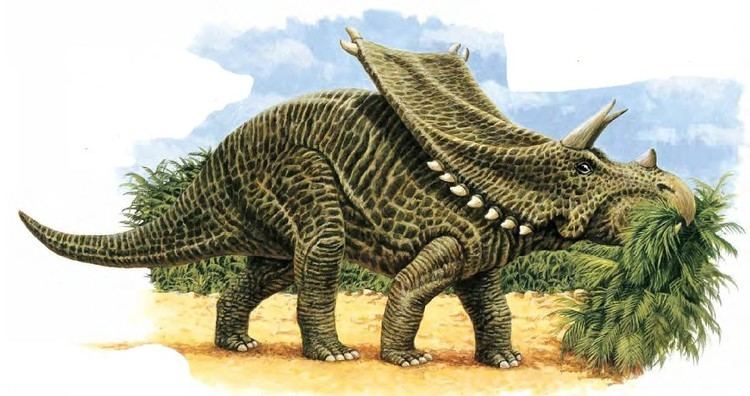 | ||
Similar Dinosaur, Ceratopsia, Ceratopsidae, Centrosaurus, Styracosaurus | ||
Dinosaur king gameplay chasmosaurus
Chasmosaurus (/ˌkæzmoʊˈsɔːrəs/ KAZ-mo-SAWR-əs) is a genus of ceratopsid dinosaur from the Upper Cretaceous Period of North America. Its name means 'opening lizard', referring to the large openings (fenestrae) in its frill (Greek chasma meaning 'opening' or 'hollow' or 'gulf' and sauros meaning 'lizard'). With a length of 4.3–4.8 metres (14.1–15.7 ft) and a weight of 1.5–2 tonnes (1.7–2.2 short tons), Chasmosaurus was a ceratopsian of average size. Like all ceratopsians, it was purely herbivorous. It was initially to be called Protorosaurus, but this name had been previously published for another animal. All specimens of Chasmosaurus were collected from the Dinosaur Park Formation of the Dinosaur Provincial Park of Alberta, Canada. C. russelli comes from the lower beds of the formation while C. belli comes from middle and upper beds.
Contents
- Dinosaur king gameplay chasmosaurus
- Carnivores dinosaur hunter chasmosaurus hunting
- Discoveries and speciesEdit
- DescriptionEdit
- PhylogenyEdit
- PaleobiologyEdit
- References
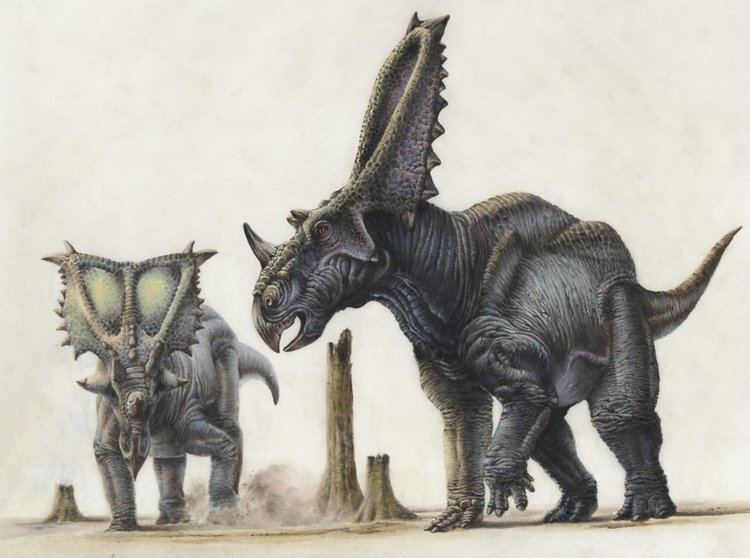
Carnivores dinosaur hunter chasmosaurus hunting
Discoveries and speciesEdit
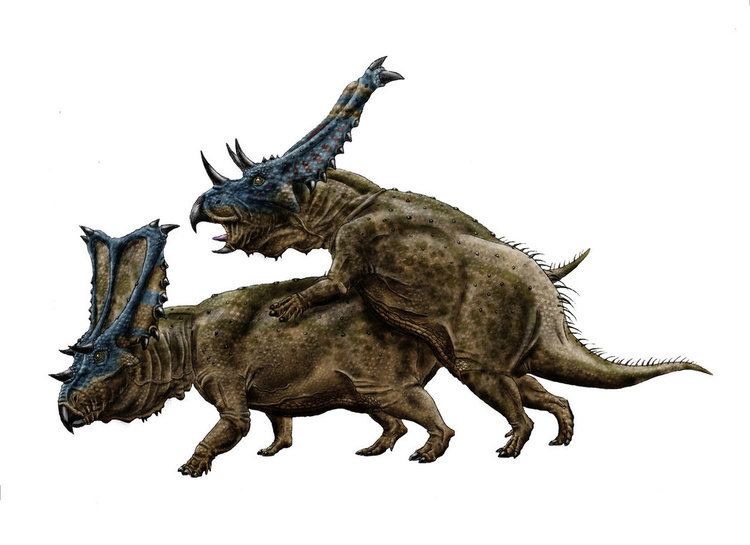
In 1898, Lawrence Morris Lambe of the Geological Survey of Canada made at the Berry Creek the first discovery of Chasmosaurus remains, holotype NMC 491, a parietal bone that was part of a neck frill. Although recognizing that his find represented a new species, Lambe thought this could be placed in a previously-known short-frilled ceratopsian genus: Monoclonius. He erected the new species Monoclonius belli to describe his finding. The specific name honoured collector Walter Bell.
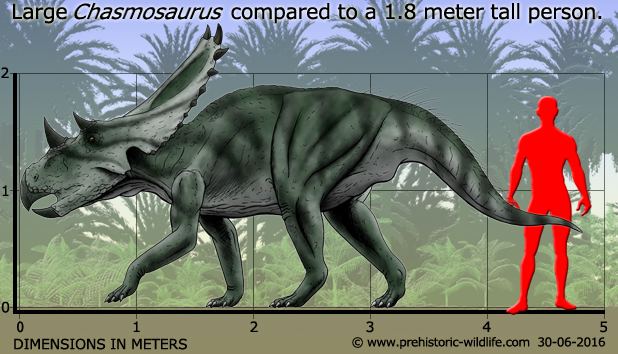
However, in 1913, Charles Hazelius Sternberg and his sons found several complete "M. belli" skulls in the middle Dinosaur Park Formation of Alberta, Canada. In January 1914, Lambe named all these finds as a separate genus: Protorosaurus, the name indicating an ancestry to Torosaurus. However, this name quickly was shown to be preoccupied by a Permian reptile, Protorosaurus, described by Meyer in 1836. Therefore, Lambe created the replacement name Chasmosaurus in February 1914. It is derived from Greek χάσμα, khasma, "opening" or "divide" and refers to the very large parietal fenestrae in the skull frill. Lambe now also assigned a paratype, specimen NMC 2245 found by the Sternbergs in 1913 and consisting of a largely complete skeleton, including skin impressions.
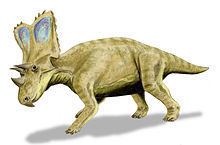
Since that date, more remains, including skulls, have been found that have been referred to Chasmosaurus, and several additional species have been named within the genus. Today some of these are considered to only reflect a morphological variation among the known sample of Chasmosaurus belli skulls; others are seen as valid species of Chasmosaurus or as separate genera. In 1933 Barnum Brown named Chasmosaurus kaiseni, honouring Peter Kaisen and based on skull AMNH 5401, differing from C. belli in having very long brow horns. This form is perhaps related to Chasmosaurus canadensis ('from Canada') named by Thomas M. Lehman in 1990. The latter species, originally Monoclonius canadensis Lambe 1902, had been described as Eoceratops canadensis by Lambe in 1915. Eoceratops and the long-horned Chasmosaurus kaiseni were thought to probably be exemplars of Mojoceratops by Nicholas Longrich, although different teams of researches have found Mojoceratops to be a synonym of Chasmosaurus russelli. Campbell and colleagues, in their 2016 analysis of Chasmosaurus specimens found Eoceratops and C. kaiseni to be referable to Chasmosaurus sp. due to the lack of the parietal preserved in the holotypes of both. Richard Swann Lull in 1933 named an unusual, short-muzzled skull, specimen ROM 839 (earlier ROM 5436) collected in 1926, as Chasmosaurus brevirostris, "with a short snout". This has been seen as a junior synonym of C. belli. Charles Mortram Sternberg added Chasmosaurus russelli in 1940, based on specimen NMC 8800 from southwestern Alberta (lower Dinosaur Park Formation). The specific name honours Loris Shano Russell. Thomas Lehman described Chasmosaurus mariscalensis in 1989 from Texas, which has now been renamed Agujaceratops. The most recently described species is Chasmosaurus irvinensis named in 2001, which stems from the uppermost beds of the Dinosaur Park Formation. This species was given its own genus, Vagaceratops, in 2010.
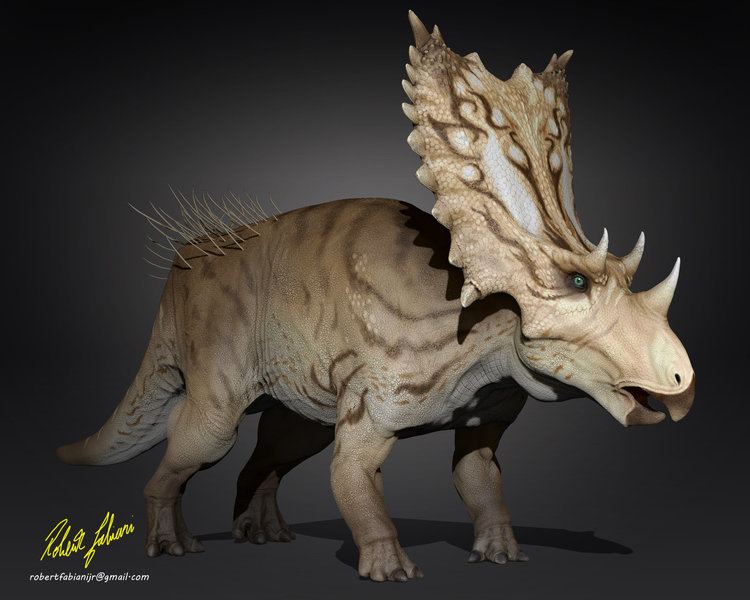
In 1987, Gregory S. Paul renamed Pentaceratops sternbergii into Chasmosaurus sternbergi, but this has found no acceptance. In 2000, George Olshevsky renamed Monoclonius recurvicornis Cope 1889 into Chasmosaurus recurvicornis as its fossil material is likely chasmosaurine; this is a nomen dubium.
Today, only two species are seen as valid: C. belli and C. russelli. They show small differences in morphology and a difference in stratigraphy, as C. russelli is found in the older lower Dinosaur Park Formation and C. belli in the middle Dinosaur Park Formation of the Campanian, together spanning a time period of 76.5 to 75.5 million years ago. Apart from the holotype and paratype several additional specimens of C. belli are known. These include AMNH 5422, AMNH 5402, ROM 843 (earlier ROM 5499) and NHMUK R4948, all (partial) skeletons with skull; and YPM 2016, a skull. Apart from its holotype C. russelli is known from its paratype CMN 8803, a skull frill; CMN 41933, a rear skull frill; RTMP 81.19.175, the right side of a skull and CMN 2280, a partial skeleton with skull found by the Sternbergs in 1914.
DescriptionEdit
Chasmosaurus was a medium-size ceratopid. In 2010 G.S. Paul estimated the length of C. belli at 4.8 metres, its weight at two tonnes; C. russelli would have been 4.3 metres long and weighed 1.5 tonnes. The known differences between the two species mainly pertain to the horn and frill shape, as the postcrania of C. russelli are poorly known. Like many ceratopsians, Chasmosaurus had three main facial horns - one on the nose and two on the brow. In both species these horns are quite short, but with C. russelli they are somewhat longer, especially the brow horns, and more curved backwards. The frill of Chasmosaurus is very elongated and broader at the rear than at the front. It is hardly elevated from the plane of the snout. With C. belli the rear of the frill is V-shaped and its sides are straight. With C. russelli the rear edge is shaped as a shallow U, and the sides are more convex. The sides were adorned by six to nine smaller skin ossifications (called episquamosals) or osteoderms, which attached to the squamosal bone. The corner of the frill featured two larger osteoderms on the parietal bone. With C. russelli the outer one was the largest, with C. belli the inner one. The remainder of the rear edge lacked osteoderms. The parietal bones of the frill were pierced by very large openings, after which the genus was named: the parietal fenestrae. These were not oval in shape, as with most relatives, but triangular, with one point orientated towards the frill corner.
The Chasmosaurus specimen NMC 2245 recovered by C.M. Sternberg was accompanied by skin impressions. The area conserved, from the right hip region, measured about one by 0.5 metres. The skin appears to have had large scales in evenly spaced horizontal rows among smaller scales. The larger scales had a diameter of up to fifty-five millimetres and were distanced from each other by five to ten centimetres. They were hexagonal or pentagonal, thus with five or six sides. Each of these sides touched somewhat smaller scales, forming a rosette. Small, non-overlapping convex scales of about one centimetre in diameter surrounded the whole. The larger scales were wrinkled due to straight grooves orientated perpendicular to their edges. From top to bottom, the large scale rows gradually declined in size. Unfortunately, nothing can as yet be learned about the coloration of Chasmosaurus from the known fossil skin impression samples.
PhylogenyEdit
Chasmosaurus was in 1915 by Lambe within the Ceratopsia assigned to the Chasmosaurinae. The Chasmosaurinae usually have long frills, like Chasmosaurus itself, whereas their sister-group the Centrosaurinae typically have shorter frills. Most cladistic analyses show that Chasmosaurus has a basal position in the Chasmosaurinae.
The following cladogram shows the phylogeny of Chasmosaurus according to a study by Scott Sampson e.a. in 2010.
PaleobiologyEdit
Chasmosaurus shared its habitat, the east coast of Laramidia, with successive species of Centrosaurus. A certain niche partitioning is suggested by the fact that Chasmosaurus had a longer snout and jaws and might have been more selective about the plants it ate.
The function of the frill and horns is problematic. The horns are rather short and the frill had such large fenestrae that it could not have offered much functional defense. Paul suggested that the beak was the main defensive weapon. It is possible that the frill was simply used to appear imposing or conceivably for thermoregulation. The frill may also have been brightly colored, to draw attention to its size or as part of a mating display. However, it is difficult to prove any sexual dimorphism. In 1933, Lull suggested that C. kaiseni, which bore long brow horns, was in fact the male of C. belli of which the females would have short ones. In 1927 C.M. Sternberg concluded that of the two skeletons he had mounted in the Canadian Museum of Nature, the smaller one, NMC 2245, was the male and the larger, NMC 2280, the female. However, today the two are referred to different species.
A juvenile Chasmosaurus belli found in Alberta, Canada by Phil Currie et al., reveals that Chasmosaurus may have cared for its young, like its relative, Triceratops, is hypothesized to have done. The juvenile measured five feet long and was estimated to be three years of age and had similar limb and frill proportions to the adult Chasmosaurus. This indicates that Chasmosaurus was not fast moving, and that juveniles did not need to be fast moving either to keep pace with adults. The fossil was complete save for its missing front limbs, which had fallen into a sinkhole before the specimen was uncovered. Skin impressions were also uncovered beneath the skeleton and evidence from the matrix that it was buried in indicated that the juvenile ceratopsian drowned during a possible river crossing. Further study of the specimen revealed that juvenile chasmosaurs had a frill that was narrower in the back than that of adults, as well as being proportionately shorter in relation to the skull.
